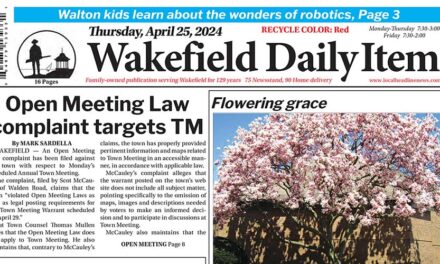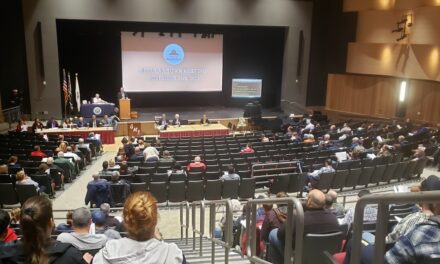By MARK SARDELLA
WAKEFIELD — The Lake Quannapowitt Committee continues to look for viable solutions to the blue-green algae problem that has plagued Lake Quannapowitt for years. Last night members discussed more possible ways to reduce or stop the inflow of phosphorus into the Lake, which is believed to be the major cause of the algae blooms.
The committee last night discussed ways to test oxygen levels at various depths in the Lake. A lack of oxygen near the bottom of the Lake is linked to an increased release of phosphorus from the Lake bottom.
The committee believes that a high percentage of the phosphorus that contributes to the algae growth is coming from storm water runoff entering the Lake from storm drains. (Committee member Alison Simcox says 85 percent of the phosphorus is coming from the storm drains, with only 15 percent originating in the Lake itself.)
Last night, the committee discussed ways to capture storm water and filter out the phosphorus. Some members of the committee believe that stopping the inflow won’t be enough to reduce the phosphorus to desired levels. They believe that there must also be a way to get the phosphorus that’s already in the Lake out of the Lake.
Last night’s discussion zeroed in on an 80 acre area of the watershed that includes the Common and nearby neighborhoods.
Committee Member Doug Heath talked about underground systems consisting of canisters with filter cartridges filled with material that would absorb the phosphorus before the storm water is discharged into the Lake. Town Engineer and committee chairman Michael Collins said that he would need to devise a way to consolidate the outfall of storm drains that feed into the Lake in order to bring the water to such a treatment system.
Heath said that an online search turned up a company that makes the underground treatment systems. He said that the company could calculate the size of the facility needed based on flow rates provided by the town.
Committee member Phil Pedros expressed concern about the committee limiting itself to the technology employed by one company. He said that there were other types of systems that might involve a small above-ground plant. Committee members agreed that other companies and other systems could also be looked at.
There was some concern about large storms that could exceed the capacity of a treatment system and undo efforts to reduce phosphorus levels. But it was pointed out that the early flow from a storm contains the greatest concentrations of harmful material. Any overflow once a system had exceeded its maximum capacity would tend to be relatively clean.
If a system or systems were employed to reduce the phosphorus, Committee member James Murphy added, any phosphorus that entered the Lake because of overflow or even a temporary system failure would still mean that far less of the nutrient would be entering the Lake on an annual basis than is currently occurring.
Collins said that Heath would gather information about the underground treatment systems and Collins would distribute it to all committee members.
—————
Murphy said that he had met with John Lovatt of Northeast Environmental Laboratory in Danvers to discuss testing the runoff waters from Walkers Brook in Reading. The committee has discussed the possibility of restoring the inflow from Walkers Brook into Lake Quannapowitt as a way to flush organic material and supporting nutrients from the Lake. Committee member Dennis Cloherty has been as strong advocate of exploring this as a simple, low-cost solution to the Lake’s problems.
Murphy presented a list of recommended tests for levels of various chemicals, heavy metals and bacteria. The total cost of the bundled testing would be $425. Murphy offered to seek funding from the Friends of Lake Quannapowitt if the committee agreed to do the testing.
But Collins and other members doubted the ability of Walkers Brook to flush out the Lake even if the brook were determined to be clean. Collins likened the idea to “running a garden hose” into the Lake and questioned the need to fund an analysis of Walkers Brook if it wasn’t a viable option. Other members felt that it was worth doing the testing because it might provide data that would rule out any possibility restoring inflow from Walkers Brook.
Ultimately, the committee deferred making a decision on the testing as it wouldn’t be done until the spring anyway.
—————
The committee will meet in January with Joan LeBlanc of the Saugus River Watershed Council. She will bring a consultant who will discuss with the committee some natural ways to capture some of the overland storm water runoff, including vegetated buffers along the Lake shore.




